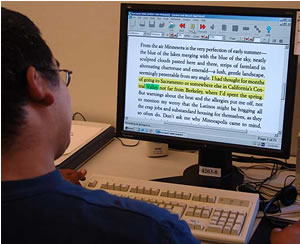
A Wisconsin university expects to save up to $10,000 a year by making a small change in computer users’ habits: Changing the fonts in the documents they print. This minor change represents an easy way for officials at every level of education to tighten their fiscal belts while school budgets decline, some experts say.
Because different fonts require different amounts of ink to print, you could be buying new printer cartridges less often if you composed documents in, say, Century Gothic rather than Arial.
Data on the subject from Printer.com, a Dutch company that evaluates printer attributes, persuaded the University of Wisconsin-Green Bay to make the switch. Diane Blohowiak, coordinator of information technology user support, has asked faculty and staff to use Century Gothic for all printed documents. The school also plans to change its eMail system so it uses Century Gothic.
“The feedback we’ve gotten so far has been positive,” she said. “Century Gothic is very readable.”
The school of 6,500 students spends about $100,000 per year on ink and toner cartridges. Although students and staff can change the default font to something more ink-intensive, Blohowiak said the university expects to save $5,000 to $10,000 per year with the font switch.
When Printer.com tested popular fonts for their “ink-friendliness,” or how little ink they used in relation to other fonts, Century Gothic and Times New Roman topped the list. Calibri, Verdana, Arial, and Sans Serif were next, followed by Trebuchet, Tahoma, and Franklin Gothic Medium. Century Gothic uses about 30 percent less ink than Arial.
The amount of ink a font drains is mainly driven by the thickness of its lines. A font with “narrow” or “light” in its name is usually better than its “bold” or “black” counterpart, said Thom Brown, an ink researcher at Hewlett-Packard Co., the world’s top maker of printers.
Also, serif fonts—those with short horizontal lines at the top and bottom of characters—tend to use thinner lines and thus less ink than a “sans serif” counterpart.
But while using less ink can help you buy fewer printer cartridges each year, it’s not necessarily better for the environment.
That’s because some fonts that use less ink, including Century Gothic, are also wider. A document that’s a full page in Arial could extend to a second page if printed in Century Gothic.
Blohowiak said her research suggests that ink comprises the main cost of a printout, but the environmental costs of paper are probably higher.
“Maybe the individual characters use less ink, but if you’re using more paper, that’s not so green, is it?” said Allan Haley, director of “words and letters” at Monotype Imaging Inc. in Woburn, Mass., which developed Century Gothic.
Also, Century Gothic was designed for limited blocks of text such as titles and headlines, not for full documents, said Haley, who describes fonts as his “children.” Despite Printer.com‘s research and UW-Green Bay’s experience, Haley said he still recommends Times New Roman or Arial for their readability.
The standard advice for trimming printing expenses still applies: Print in “draft mode,” if you can. Use both sides of a page, and do a print preview to make sure you’re not printing pages with useless text. Using an ink-saving font is just one more technique to consider.
And the greenest way to save on ink is not to print at all.
That’s the philosophy Microsoft Corp. said it uses in deciding which fonts to include in its Outlook and Word applications. The more pleasing a font looks on the screen, the less tempted someone will be to print, said Simon Daniels, a program manager for Microsoft’s typography group.
That’s why the company changed its defaults in Office 2007 from Arial and Times New Roman to Calibri and Cambria, he said.
“We’re trying to move the threshold of when people hit the print button,” he said.
Link:
- Research: Social media has negative impact on academic performance - April 2, 2020
- Number 1: Social media has negative impact on academic performance - December 31, 2014
- 6 reasons campus networks must change - September 30, 2014
